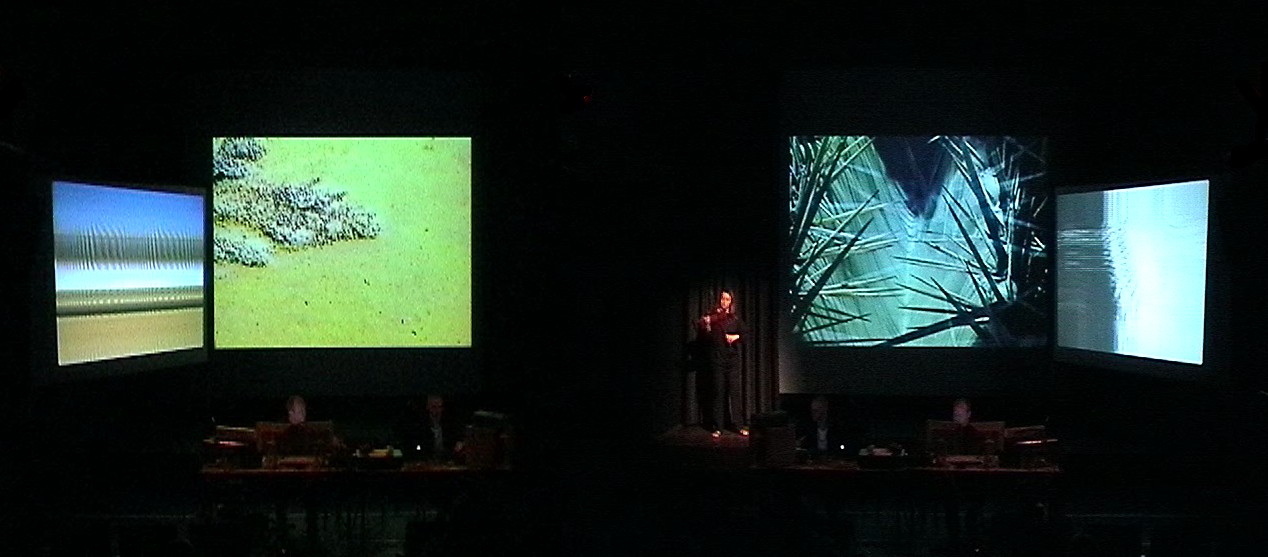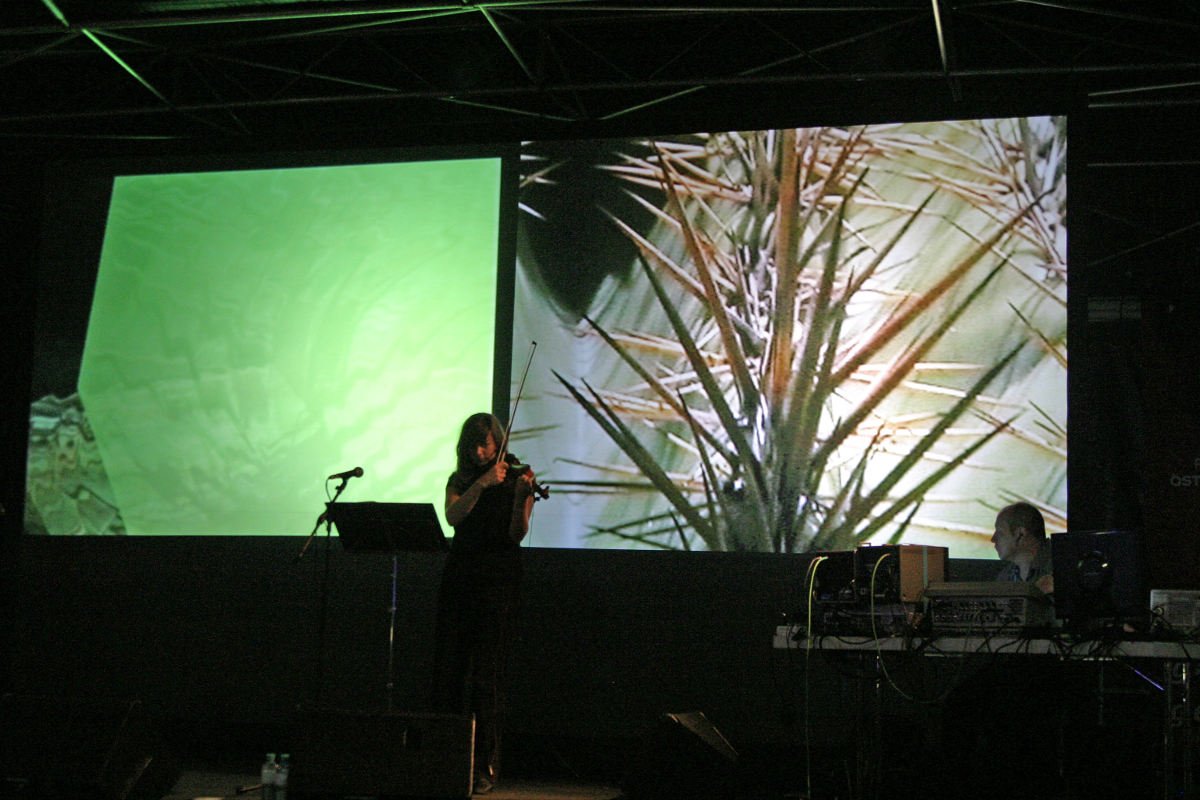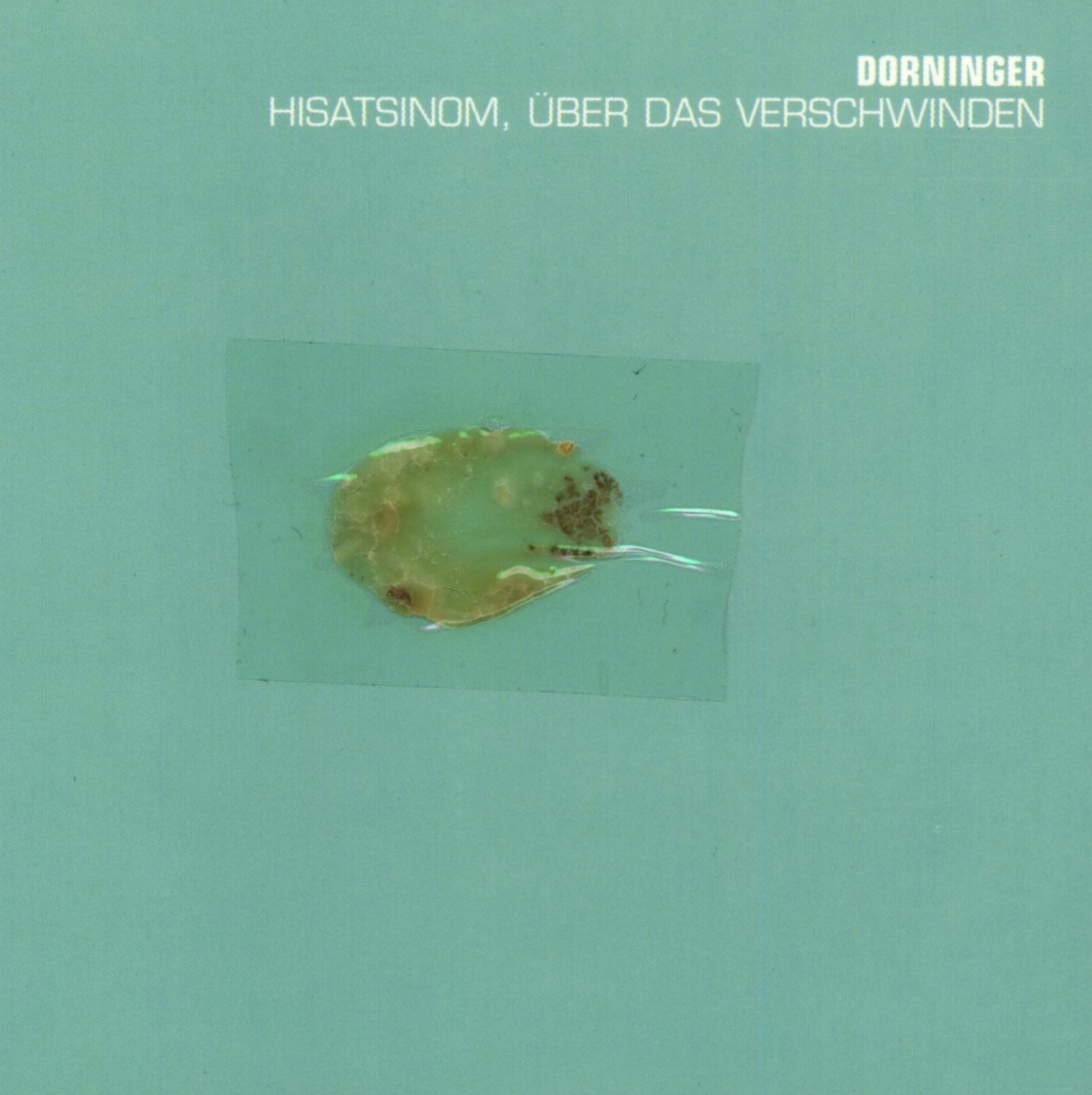Crossmedia March 14, 2001
Live / CD: "Hisatsinom, über das Verschwinden" by Dorninger

„Hisatsinom, über das Verschwinden"
Teil 1 der Trilogie Verschwinden / Perspektive / Utopia
Premiere: "4020" Festival in Linz Austria (14.3.2001, Skyloft - Ars Electronica Center)
Das Thema: Das Verschwinden und die Transformation kultureller Codes.
Aufhänger: Der Untergang der Hisatsinom (Anasazi) Kultur im Gebiet Four Corners (Utah, Colorado, New Mexico & Arzizona). Die Stücke tragen Titel wie: „The End of Chaco", „Synchronised Minds", „Relation, Etappe der Beliebigkeit", „Kollektive Halluzination" oder „Silence" und behandeln Themenkreise wie die Synchronisation des Einzelnen, die Beseitigung natürlicher Schranken oder den Funktionalismus in der Musik.
Musik: Die Musik basiert auf elektronischen Elementen, elektronisch modulierten Naturinstrumenten und field recordings. Live wird die Musik um Electronics, Geige und Gesang erweitert.
Video: Es gibt 2 Videoprojektionen auf 3 Projektionsflächen mit unterschiedlichem Material. Projektion 1 zeigt in einer Art Slideshow nahezu ungewegte extreme Nahaufnahmen von organischem Material, während Projektion 2/3 Text- und Bildanimationen (Dietmar Bruckmayr) und stückbezogenes moduliertes Bildmaterial zeigt.
Mitwirkende: Martha Breit (Geige, DJ, Geigenbogenbauerin), Manu Pfaffenberger (Visual Artist, Kostümbildnerin und Sängerin), Dietmar Bruckmayr (Performer, Visual Artist), David Eugene Edwards (Komponist, Sänger und Gitarrist der US-Folk-Rockband Woven Hand), Wolfgang Dorninger (Musiker, Komponist und Labelbetreiber).
CD: „Hisatsinom, über das Verschwinden" auf base records.
Der Ausagangspunkt: Die Kultur der Hisatsinom. Chaco Canyon war das Zentrum und Archiv für das religiöse und esoterische Wissen der Hisatsinom, aber auch eine Art Kalender für Zeremonien und Riten. Ihre Pueblos wurden beim Bau exakt auf die Zyklen des Mondes und die Bewegung der Sonne ausgerichtet um auf diese Weise ihr kosmologisches Weltbild auszudrücken, als ein Masterplan einer Kultur ohne Schrift. Aber innerhalb von zwei Generationen kollabierte diese Hochkultur (800 b.c. - 1350 a.d.) und zerbrach. Bis 1995 gab keine wissenschaftlich beweisbaren Erkenntnisse über das plötzliche Ende dieser Kultur. Vertretbare Spekulationen von einer „große Dürre" oder langanhaltenden Kriegen gingen einher mit Phantasien über Sternentore von Akte X-Autoren. Die Hisatsinom-Gesellschaft wurde von einer priesterähnlichen Gesellschaft geleitet, die als „Vertreter" der Götter auf Erden fungierten. Ihr außerordentliches Wissen in Astronomie, Geometrie und Biologie festigten diese Position als Boten der Götter. Sie konnten deshalb den Sommermonsun oder die Winterregenfälle vorhersagen. Für die einfachen indianischen Bauern waren sie somit die Beherrscher der Natur. Eine Klimaverschiebung dürfte Mitte des 13 Jhdts. die Unfehlbarkeit dieser Gottesboten zerstört haben. Die Versuche die Götter durch noch größere Bauten und Straßen zu besänftigen, schlugen somit fehl. Der starke Glaube der Hisatsinom-Gesellschaft begann rapide abzunehmen, neue Religionen - „erdbezogener und demokratischer" wie der Kachinismus - lockten im Süden. Die Bande zerbrach, die Zeichen der „Götter" verloren ihre Macht, eine spirituelle Krise von derart katastrophaler Wirkung führte zum Kollaps einer Hochkultur. Und als die Hisatsinom ihre Stätten verließen, nahmen sie nichts von ihrer alten Kultur mit sich. Es sieht aus, als wollten sie diese Zeichen für immer auslöschen. Das Stück „Hisatsinom, über das Verschwinden" basiert auf dieser Geschichte, bezieht sich aber großteils auf Phänomene des Verschwindens in unserer Zeit. Texte, die amerikanischen Themen behandeln werden in englischer Sprache abgehandelt, europäische in Deutsch. Übersetzungen gibt es zum Teil auf Video. Research: Die Publikationen „Ästhetik des Verschwindens" von Paul Virilio, „Musik und Vergessen" von Daniel Charles (beide Merve Verlag), „A Primary Architecture of the Chacoan Culture" von Anna Sofaer, „High Noon on Old Bonito" von Stein, Suiter und Ford, „The Prehistoric Pueblo World A.D. 1150 - 1350" von Michael A. Adler und „Social Strife May Have Exiled Ancient Indians" von Georg Johnson waren mehr als nur „treue Begleiter" für das Stück.
Wolfgang Dorninger
Hisatsinom, über das Verschwinden 2001
Crossmedia performance
Uraufführung: "4020" Festival in Linz Austria (14.3.2001, Skyloft - Ars Electronica Center)
Weitere Aufführungen: blackbox, München 18.5.2002 - organized by T.U.B.E, Linzfest 27.5.2007, Linz
Sponsors: Kulturamt der Stadt Linz, Kulturabteilung des Landes OÖ, SKE-Fond der austro mechana, Ars Electronica Center/Future Lab (Videodept.)
Thanks for support: Bob Ferbrache/Absinthe Studio (for recording David E. Edwards and dubbing it onto track 1 & 3), Jörg Lehner, Gerfried Stocker, Jutta Schmiederer, Volker Christian (all Ars Electronica Center), Dr. Peter Leisch (Kulturamt der Stadt Linz), Taya Pockock, Tucson/Pima Library, Arizona State Museum, Neighbors at Prince Gardens, Eisserer & Dorninger GesbR, Die Jungs (PR), Schmid & Viteka (Livesound), family & friends
Lyrics
Introduction
The Chacoan Complex Chaco Canyon was a central archive for esoteric knowledge, in which the region's ceremonial calendar for the Hisatsinom society was maintained. The Chacoan pueblos were built according to solar and lunar orientations to express the Chacoans' concepts of the cosmos, as a masterplan of a society without a written language to worship their gods. But within two generations the high culture of the Hisatsinom (800 b.c. - 1350 a.d.) collapsed.
It was not the "great drought" or raids who drove these people away from their gigantic pueblos, streets and gardens on which they had worked so hard. Had that been the case, the Hisatsinom would have re-established their religious structures in new homelands. The Hisatsinom society was led by a priest community, which claimed to have a "direct" link to the gods. They were knowledgeable in astronomy, geometry and the effects of solar and lunar cycles on nature.
The indian farmers built these oversized and overembellished pueblos to appease the gods and hoping for plentiful rain and mild living conditions. Finally a change in the climate led to to the recognition that their prophecies had been wrong, which broke the strong belief of the Hisatsinom people. The link broke, the codes lost their power, a spiritual crisis, catastophic enough to cause a collapse of this civilisation, took place.
New religions like the Kachina cult, vibrant, flashy and more democratically stuctured made the Hisatsinom people leave their pueblos behind. Once the Hisatsinom had left the old empire, it seems like, their ideological slate was wiped clean.
Voices From Chaco
(Wolfgang F. Dorninger)
The eternal links broke
The codes lost their power
A spiritual crises occured
Those who came before
Left their gigantic pueblos
A civilisation collapsed
Can you hear the voices of Chaco
Can you read the signs
Silence seized Chaco
A masterplan built of stone
Expressing their universal ideas
The absence of rain quickened the build
Of oversized pueblos and glorious streets
To appease the gods and call forth their blessings
Can you hear the voices of Chaco
Can you read the signs
Barren fields of corn - identity lost
The communion of fruit and rain delayed
The prophesized truths crumbled and shattered
The dread of gods punishment lost its effect
New vibrant earthy religions called them far south
The old empire's ideological slate was wiped clean
Can you hear the voices of Chaco
Can you read the signs
Synchronized Minds
(Wolfgang F. Dorninger)
Speak to eyes and people will follow
Light up the night for eternal delight
Move on, you are speed, already machine
Run by corporate dreams
No beginning, no end
No pain, no death
The high speed of motion forces absence
From channel to ad from channel to ad
Car windows turn into screens
Where reality mixes with unreal scenes
No beginning, no end
No morning, no day
Bizarre things get trite
and common facts excite
Promoting a 5 minute star scenery
In a world without memory
No beginning, no end
No shadow, just light
Technology as metaphor for world
Promoted as senseful revolution
To free you from limits and confines of time
Living in the pearl light of divine
No beginning, no end
No mind, no love
Thanks to Taya Pockock for support!
For more information:
base records
Review Westzeit
Review Skug
Vortrag Kepler Salon
Video "Apatheia" - dorfTV


Latest article
- Award: Großer Landespreis für Kultur 2025
- Radio: Fadimat105 on Thuesday, January 6th!
- Album: "No Way Out" by Dorninger - base[records]
- All Dates, Shows, Performances, ...
- October 27th: Bandcamp Listening Party
- Video: "Bruckner Remixed In Space" - a clip & a summary
